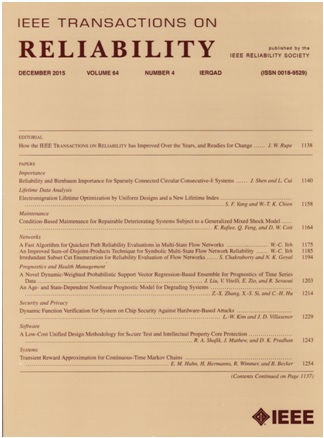常规多处理器系统笛卡儿幂的分量(额外)边连通性注释
IF 5.7
2区 计算机科学
Q1 COMPUTER SCIENCE, HARDWARE & ARCHITECTURE
引用次数: 0
摘要
多处理机系统的可靠性评估为多处理机系统的布局和优化提供了理论基础。$h$ -extra - edge-connectivity $\lambda _{h}$和$k$ -component - edge-connectivity $c\lambda _{k}$作为经典边缘连接的扩展,是测量多处理器系统可靠性的两个精确指标。对于多处理器系统,确定大型$k$的$c\lambda _{k}$和$\lambda _{k}$仍然是困难的。用$\delta _{G}(0)=0$和$\delta _{G}(i)=\frac{1}{2}(\text{ex}_{i+1}(G)-\text{ex}_{i}(G))$表示$i\in \lbrace 1, \ldots, |G|-1\rbrace$,其中$\text{ex}_{i}(G)={\mathrm{max}}\lbrace 2|E(G[S])|: S\subseteq V(G), |S|=i \rbrace$。在本文中,我们得到了$d$ -正则图的笛卡尔幂的$c\lambda _{k}$和$\lambda _{h}$,对于这些正则图,字典顺序产生最优顺序,对于$i=0, 1, \ldots, \lfloor \frac{|G|-1}{2}\rfloor$,我们得到了$\delta _{G}(i)\leq \frac{d}{2}$。我们的结果改进了Yang等人(2023)关于Hamming图的$c\lambda _{k}$和Tian等人(2022)关于完全图的笛卡尔幂$K_{4}$的$\lambda _{h}$的一些先前的结果。本文章由计算机程序翻译,如有差异,请以英文原文为准。
A Note on the Component (Extra) Edge Connectivity of the Cartesian Powers of Regular Multiprocessor Systems
Reliability assessment of multiprocessor systems presents the theoretical foundation for the layout and optimization of multiprocessor systems. The $h$ $\lambda _{h}$ $k$ $c\lambda _{k}$ $c\lambda _{k}$ $\lambda _{k}$ $k$ $\delta _{G}(0)=0$ $\delta _{G}(i)=\frac{1}{2}(\text{ex}_{i+1}(G)-\text{ex}_{i}(G))$ $i\in \lbrace 1, \ldots, |G|-1\rbrace$ $\text{ex}_{i}(G)={\mathrm{max}}\lbrace 2|E(G[S])|: S\subseteq V(G), |S|=i \rbrace$ $c\lambda _{k}$ $\lambda _{h}$ $d$ $\delta _{G}(i)\leq \frac{d}{2}$ $i=0, 1, \ldots, \lfloor \frac{|G|-1}{2}\rfloor$ $c\lambda _{k}$ $\lambda _{h}$ $K_{4}$
求助全文
通过发布文献求助,成功后即可免费获取论文全文。
去求助
来源期刊

IEEE Transactions on Reliability
工程技术-工程:电子与电气
CiteScore
12.20
自引率
8.50%
发文量
153
审稿时长
7.5 months
期刊介绍:
IEEE Transactions on Reliability is a refereed journal for the reliability and allied disciplines including, but not limited to, maintainability, physics of failure, life testing, prognostics, design and manufacture for reliability, reliability for systems of systems, network availability, mission success, warranty, safety, and various measures of effectiveness. Topics eligible for publication range from hardware to software, from materials to systems, from consumer and industrial devices to manufacturing plants, from individual items to networks, from techniques for making things better to ways of predicting and measuring behavior in the field. As an engineering subject that supports new and existing technologies, we constantly expand into new areas of the assurance sciences.
 求助内容:
求助内容: 应助结果提醒方式:
应助结果提醒方式:


